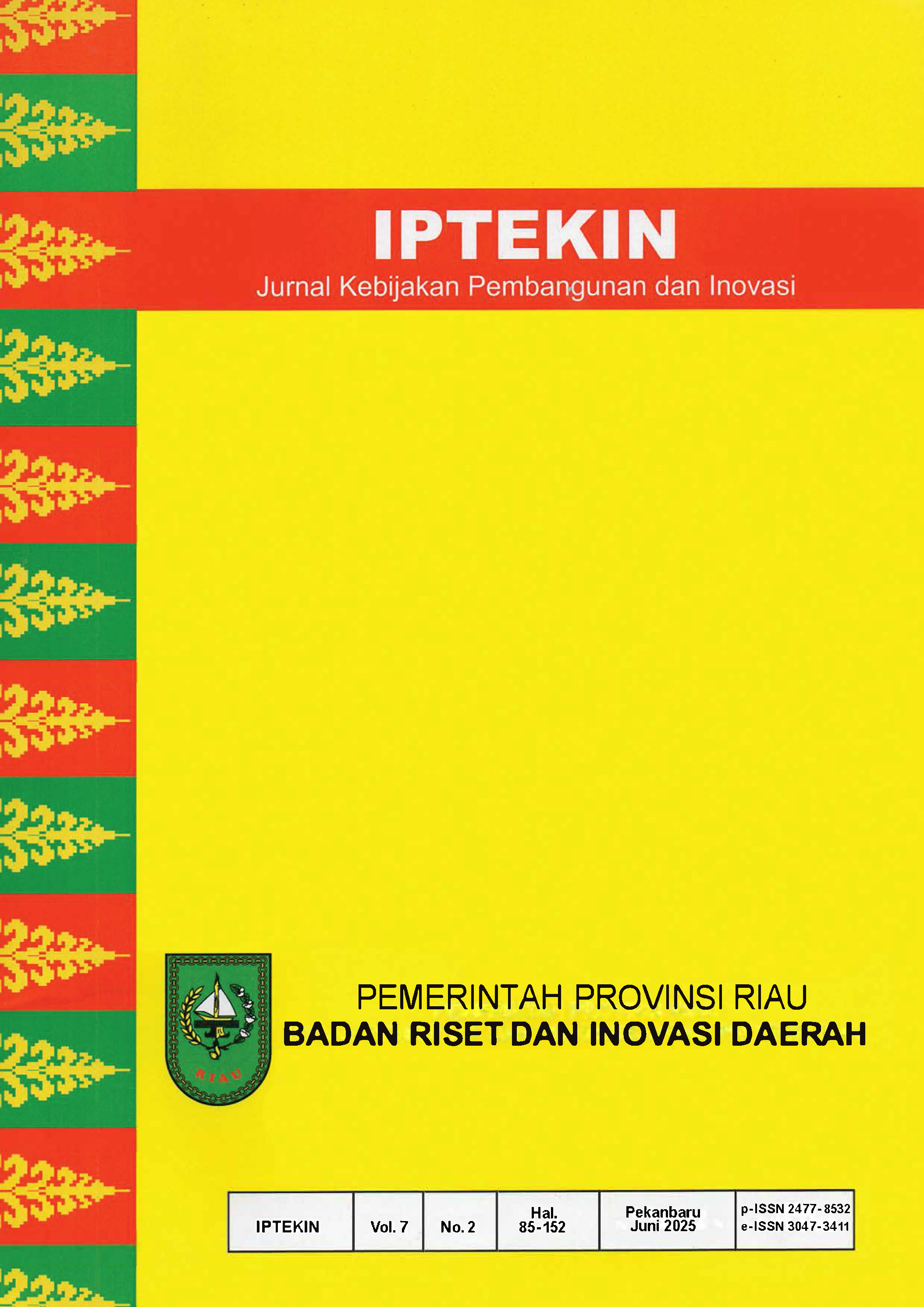Penggunaan MKJI 1997 dalam Rekomendasi Kebijakan Pengaturan Sinyal Lalu Lintas di Pekanbaru Studi Kasus : Simpang Parit Indah
Main Article Content
Abstract
The signaled intersection of Jalan Parit Indah in Pekanbaru City is one of the significant congestion points due to the high volume of vehicles and the suboptimal timing of signals. This study aims to evaluate the performance of intersections based on the Indonesian Road Capacity Manual 1997 (MKJI) method and to prepare recommendations for more effective signal timing. The research was conducted for three days during the peak hours of morning, noon, and evening, with the collection of primary data in the form of vehicle volume, speed, and intersection geometry. The data were analyzed using the 1997 MKJI approach to calculate the saturation current, degree of saturation, queue length, and delay in existing conditions and conditions after alternative signal settings were applied. The results of the analysis showed that in the existing conditions, the intersection was within the LOS F service level, with high queue lengths and delays. After modifying the signal time based on the MKJI method, there was a decrease in the average queue length by 20 meters and an improvement in traffic delays. This study provides evidence that signal time optimization based on MKJI 1997 can be the basis for the formulation of technical policies for urban traffic regulation, especially at intersections with high traffic flow. The recommendations of the results of this study are expected to be input for the Pekanbaru City Transportation Agency in making decisions related to improving the efficiency of signaled intersections.
Article Details

This work is licensed under a Creative Commons Attribution-ShareAlike 4.0 International License.
References
Badan Pusat Statistik Kota Pekanbaru. (2022). Kota Pekanbaru dalam angka 2022.
Dinas Perhubungan Kota Pekanbaru. (2023). Laporan Kinerja Instansi Pemerintah (LKJIP) Dinas Perhubungan Kota Pekanbaru Tahun 2022–2023.
Elsa Tri Mukti, M. N., & Sopian, S. (2023). Application of the VISSIM program in evaluation and improving the performance of unsignaled intersections in Pontianak City. Jurnal Teknik Sipil Universitas Tanjungpura, 24(2), 104–112.
Firdausi, A. P., Putra, W., & Hafizah, R. (2022). Simulation using MKJI 1997 and VISSIM to analyze effect of road marking on intersection delay. Journal of Infrastructure and Transportation, 8(3), 75–84.
Ghaderi, R. (2021a). A comprehensive model of signalized intersection performance under varying traffic demands. Transportation Research Record, 2675(10), 430–444. https://doi.org/10.1177/03611981211011640
Ghaderi, R. (2021b). Evaluating signalized intersection performance in mixed traffic conditions. Transport Policy, 100, 34–45. https://doi.org/10.1016/j.tranpol.2021.07.010
Hafizah, N. El, & Firdausi, M. (2021). Analisis karakteristik parkir, drop off dan pick up area berdasarkan demand Bandara Juanda Surabaya. Jurnal Teknik Sipil, 1(2), 121–128. https://doi.org/10.31284/j.jts.2020.v1i2.1411
Hasibuan, D. Y. F. C., & Muttaqin, M. Z. (2021). Analisis kinerja simpang tak bersinyal persimpangan Pasar Sibuhuan, Kabupaten Padang Lawas, Sumatera Utara. Jurnal Saintis, 21(1).
Hormansyah, D. S., Sugiarto, V., & Amalia, E. L. (2016). Penggunaan Vissim model pada jalur lalu lintas empat ruas. Jurnal Teknologi Informasi. https://doi.org/10.36382/jti-tki.v7i1.194
Izha, R. (2023). A decision support system for priority calculation of travel routes using Analytical Hierarchy Process. International Journal for Applied Information Management, 3(1), 33–45. https://doi.org/10.47738/ijaim.v3i1.41
Lestari, N. G. (2015). Pengelolaan sistem transportasi oleh Dinas Perhubungan Kota Pekanbaru Tahun 2013-2015. Journal of Applied Microbiology, 119(3), 1–14.
Li, Y., & Zhao, X. (2022). Cost-effective signal optimization strategies in mid-sized Asian cities: Case study in Nanjing. Asian Transport Studies, 8(1), 1–13. https://doi.org/10.1016/j.eastsj.2022.100123
Musyarofah, H. I., Widodo, W., & Agustriono, H. (2012). Evaluasi kinerja detektor adaptif pada sistem ATCS (Area Traffic Control Sytem) (Studi kasus : Simpang Gamping, Yogyakarta) mengkaji dan mengidentifikasi kinerja detektor adaptif pada sistem ATCS (area traffic contro system) merupakan langkah awal.
Muttaqin, M. Z., Munawar, A., & Irawan, M. Z. (2022). Development of a pedestrian capacity using a movement simulation model in Malioboro, Yogyakarta, Indonesia. ASM Science Journal, 17(1). https://doi.org/10.32802/asmscj.2022.1282
Pebriyetti, Widodo, S., & Akhmadali. (2018). Penggunaan software Vissim untuk analisa simpang bersinyal (Studi kasus : Simpang Jalan Veteran, Gajahmada, Pahlawan dan Budi Karya Pontianak, Kalimantan Barat). Jurnal Mahasiswa Teknik Sipil Universitas Tanjungpura, 5(3), 1–14.
Pratama, P. (2016). Penggunaan jalur pejalan kaki di Koridor Jalan Pahlawan dan Jalan Pemuda Kota Semarang oleh masyarakat difabel. Jurnal Pembangunan Wilayah & Kota, 12(3), 336. https://doi.org/10.14710/pwk.v12i3.12908
Putri, H. A., & Nugroho, A. P. (2021). Analisis spasial kinerja simpang di kawasan mixed-use. Jurnal Wilayah Dan Lingkungan, 9(2), 101–114. https://doi.org/10.14710/jwl.9.2.101-114
Putriningtiazti, A., Azwansyah, H., & Mayuni, S. (2024). Performance evaluation of signalized intersections using MKJI 1997, PKJI 2023, and PTV VISSIM software (Case study: Jakarta–Pontianak corridor). Jurnal Teknik Sipil Universitas Tanjungpura, 24(4), 1609–1622.
Rao, K. R., & Mathew, T. V. (2023). Critical review of intersection control strategies under heterogeneous traffic. Transportation Research Part C: Emerging Technologies, 144, 103911. https://doi.org/10.1016/j.trc.2022.103911
Rao, S., & Mathew, T. V. (2023). Revisiting signalized intersection analysis under heterogeneous traffic using revised capacity models. Transportation Research Part A: Policy and Practice, 169, 103507. https://doi.org/10.1016/j.tra.2022.103507
Sandhyavitri, A., Maulana, A., Ikhsan, M., Putra, A. I., Husaini, R. R., & Restuhadi, F. (2021). Simulation modelling of traffic flows in the central business district using PTV Vissim in Pekanbaru, Indonesia. Journal of Physics: Conference Series, 2049(1), 12096. https://doi.org/10.1088/1742-6596/2049/1/012096
Soehandoko, S. (2023). Analisis kinerja simpang bersinyal (Studi kasus simpang Dungus di Kabupaten Ngawi). Jurnal Teknik Sipil Dan Perencanaan, 13(1), 27–35.
Tarko, A. P., & Perez-cartagena, R. I. (2005). TRB 2005 Annual Meeting CD-ROM Paper revised from original submittal.
Zhao, L., & Sun, J. (2013). Simulation framework for vehicle platooning and car-following behaviors under connected-vehicle environment. Procedia - Social and Behavioral Sciences, 96, 914–924. https://doi.org/10.1016/j.sbspro.2013.08.105
Zhao, P., Diao, J., & Li, S. (2017). The influence of urban structure on individual transport energy consumption in China’s growing cities. Habitat International, 66, 95–105. https://doi.org/10.1016/j.habitatint.2017.06.001

